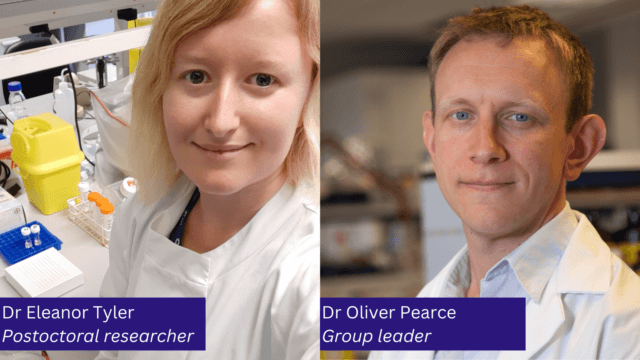Ovarian cancer's protective barrier: how the tumour matrix teaches cells to disarm immune attack
A structure surrounding ovarian cancer trains cells called macrophages to protect the tumour from immune attack, according to new research led by Barts Cancer Institute, Queen Mary University of London. The work uncovers tactics that the tumour uses to disarm the immune system and points towards potential therapeutic strategies to overcome the cancer’s defences and treat patients more effectively.
The extracellular matrix is a network of scaffolding that surrounds our cells and helps to maintain the 3D shape and structure of our tissues. Tumours manipulate and rearrange this structure as they develop to support their growth and spread. However, new research shows that the matrix is not merely an inert skeleton, but a dynamic and active accomplice in tumour development. “The matrix was previously seen as a bystander in this process,” Dr Oliver Pearce explains. “But recently, people have realised that it has a direct functional effect on how tumours develop and, most importantly, how tumours are likely to respond to treatment.”

The matrix provides a line of defence around tumours that excludes and disarms immune cells, blocking them from attacking the cancer. This can cause potentially potent immunotherapies to fail, as their ability to boost the immune system’s power to fight cancer is rendered useless if immune cells cannot infiltrate the tumour.
“We wanted to find out: what are the important components of the matrix that suppress the immune system?” explains Dr Eleanor Tyler, postdoctoral researcher in Dr Pearce’s lab and co-first author on the new paper, “and can we target these to improve immune infiltration and the efficacy of therapies?”
In the new study, published in Nature Communications, Dr Tyler analysed data from tumour samples from 12 different types of cancer, including ovarian cancer. She found that patients’ disease progressed more rapidly when the matrix around their tumour contained a set of five key molecular building blocks. Interestingly, matrix built this way often contained cells called M0 macrophages, a mysterious class of immune cells that remains poorly understood.
This raised several questions: are these cells helping to suppress an immune response and protect the tumour? And why are these macrophages so abundant in matrix containing these five molecules?

A school for immunosuppressive cells
The researchers speculated that the tumour matrix could be operating like a school, training immature immune cells to become M0 macrophages. To test this theory, they took samples of ovarian tumours and stripped away all of the cells, leaving behind the architecture of the matrix, fully intact.
Next, the team introduced immature cells called monocytes into this structure. “To our surprise, the monocytes we put into this model matured into macrophages similar to the M0 cells we saw in human tumour tissues without any other stimulus. The matrix instigates this change by itself,” Dr Pearce comments.
In collaboration with colleagues at the University of Basel, Switzerland, the researchers also revealed that their M0 macrophages can suppress components of the immune response – such as T cells, which play an important role in tumour killing. T cells incubated with these macrophages did not proliferate as quickly and showed signs of being deactivated.
These results could pave the way for new drugs that target parts of the matrix and disrupt its ability to suppress immune responses to the tumour. Dr Pearce and his team are already working with biotech companies to develop potential therapies that target aspects of the matrix and lower the tumour’s defences. These approaches could be used in combination with immunotherapies to boost their efficacy and improve patients’ survival.
Developing a unique tool for studying the tumour matrix
The team’s technique of stripping cells away from tumours to leave an intact matrix will also be an invaluable tool for future research. “This model is a unique element of this study – it maintains the exact composition and mechanical properties of the matrix, reproducing what we see in patient tumours in a way that other models don’t,” explains Dr Pearce.
Following this study, Dr Pearce’s lab and other groups have been using this model to answer a multitude of different questions – such as how the matrix affects cell therapies like CAR-T, or how it shapes the dynamics of immune cells moving through this structure.

The group is also starting to develop models similar to this ovarian cancer one for other cancer types, such as breast and pancreatic cancer. They hope to build a service that will enable other researchers and companies to harness this model for their own work. Ultimately, the model could provide the foundation for a multitude of advances in understanding the matrix in cancer in the future, supporting the development of a range of new tools that tear down cancer’s defences and enable us to treat it more effectively.
This work was funded thanks to support from the Centre for Inflammation and Therapeutic Innovation, Cancer Research UK & Credit Suisse, Barts Charity & Against Breast Cancer, and the Medical Research Council.
Category: General News, Publications

No comments yet